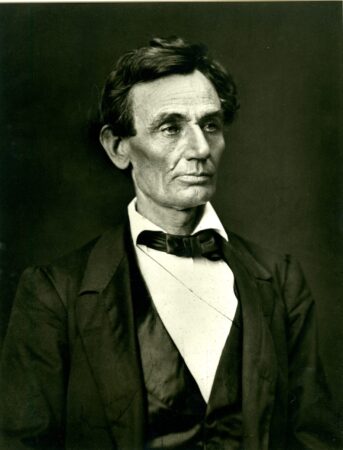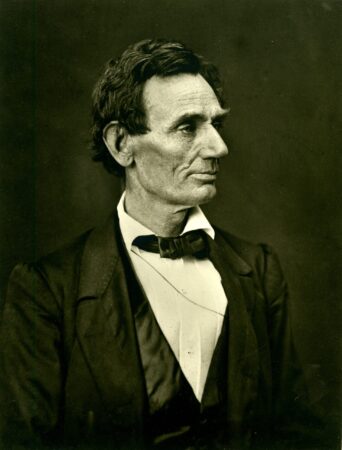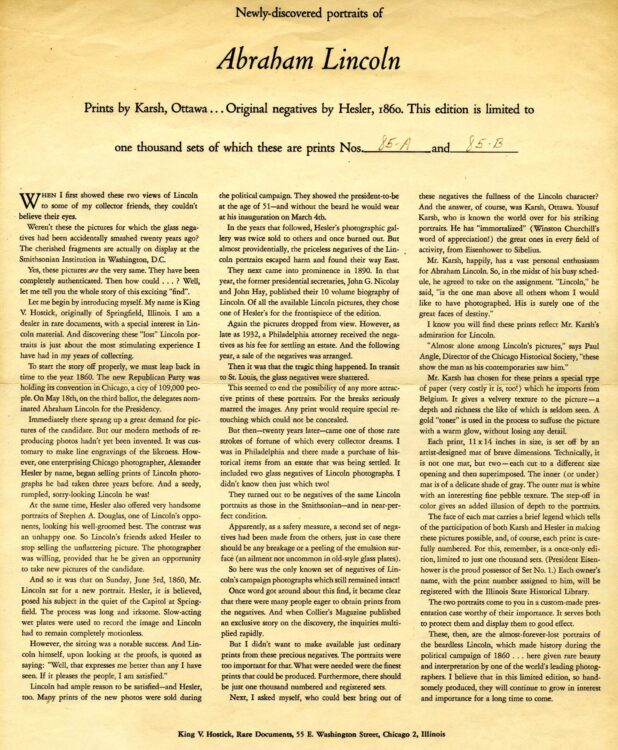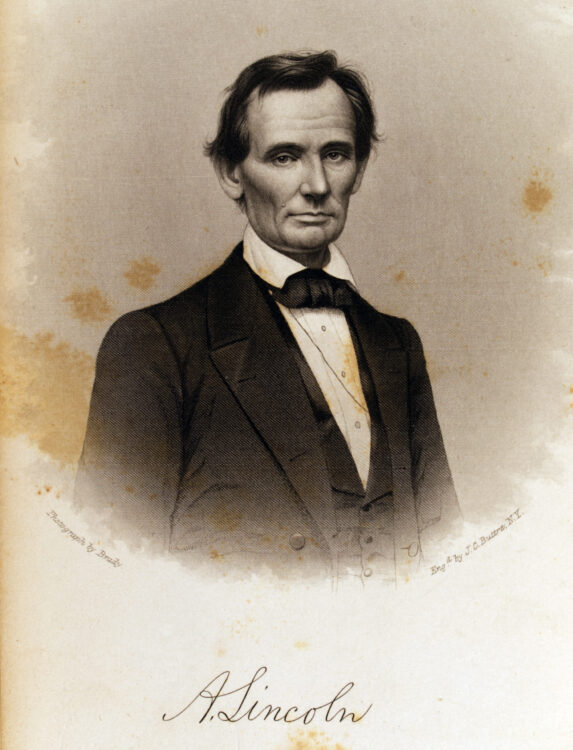Promotion of Lincoln as a national candidate involved circulation of his speeches and biographical profiles through the Republican Party’s political tracts and newspapers, especially Horace Greeley’s anti-slavery and reform-minded Tribune. Equally important was promotion of new imagery of the presidential candidate through photographs circulated as cartes-de-visite and published illustrations, usually line engravings drawn from the photographs.
Scripps, J. L. (John Locke). Life of Abraham Lincoln. New York: [Horace Greeley], 1860.
Published as Tribune Tract No. 6, John Scripp’s Life of Abraham Lincoln was one of the earliest biographical profiles of the new Republican presidential nominee.
Greeley’s New-York Tribune reached daily, semi-weekly, and weekly subscribers of local and national news, also circulating advertisements for other Tribune publications, such as the Lincoln campaign biography. Offering subscription discounts to Lincoln Clubs, Greeley promoted the Tribune as “earnest champion of Liberty, Progress, and of whatever will conduce to our national growth in Virtue, Industry, Knowledge, and prosperity.”
Washburne, E. B. (Elihu Benjamin). Abraham Lincoln, his personal history and public record. [Washington, D.C.]: published by the Republican Congressional Committee, 1860.
One of the important testimonies for the new Republican Party nominee was delivered in the U.S. House of Representatives by the seasoned political orator, Illinois Congressman Washburne, who had known Lincoln since 1840. Among other episodes from Lincoln’s personal history, Washburne relayed the story of the Illinois Republican State Convention’s early and enthusiastic endorsement of Lincoln as “the rail candidate” for 1860. From the floor of the state convention, Lincoln’s former fellow-laborer, John Hanks, presented “two old-time fence rails, decorated with flags and streamers” bearing the inscription, “the Rail Candidate for President in 1860. Two rails from a lot of 3,000 made in 1830 by John Hanks and Abe Lincoln.”
Washburne’s speech, along with the Republican platform adopted May 17, 1860, was published by the Republican Congressional Committee and sold as campaign literature at a price 50 cents per hundred copies.
Portraits of the Rail-Splitter
Championed as a self-made man of humble origins, familiar with the hard labor of splitting rails during frontier farm work, Lincoln had a rugged appearance. He was six feet four inches tall, “rail thin” at 180 pounds, with one drooping eye, big ears, a swarthy complexion, generally unkempt hair, and little regard for the fit of his clothing, as depicted in the 1858 photograph taken by T. P. Pierson in Macomb, Illinois. The Matthew Brady photograph of Lincoln, taken the day of his address at the Cooper Institute in February, was much more flattering and popularized by circulation of Buttre’s engraved prints of the presidential campaign candidates.
Thompson, J. C. (Jacob Champion). Manuscript 2: Where did Mr. Lincoln first receive the news of his nomination?; [and,] did Mr. Lincoln play hand ball? Revised edition. Springfield, Illinois: Lincoln Foundation Incorporated, 1925.
The half tone used as a frontispiece to this booklet is from a photograph of the ambrotype made by T. P. Pierson in Macomb, Illinois, August 27, 1858. James K. Magie sold the photograph to Richard Watson Gilder, editor of the Century magazine. Unfortunately, the photograph was destroyed by fire in the Century Company offices in 1888.
Hon. Abraham Lincoln, Republican candidate for sixteenth president of the United States. New York: Currier & Ives, 1860. MSS 0521 Lincoln Club of Delaware Abraham Lincoln collection
This early Currier & Ives campaign portrait is based on pre-Matthew Brady imagery of Lincoln.
Hesler's portrait
Shortly after securing his party’s nomination at the Chicago convention, on June 3, 1860, Lincoln was photographed by Chicago photographer Alexander Hesler. Lincoln’s supporters had arranged the sitting, making a deal with Hesler to stop circulating an earlier, less photogenic image that Hesler had made of Lincoln in 1858. With his subject better groomed, Hesler’s studio photograph of Lincoln sold many prints during the political campaign.
Hesler, Alexander (photographer). Beardless Republican nominee, Abraham Lincoln, from a sitting on June 3, 1860, Springfield, Illinois. Printed by Yousef Karsh, circa 1956. MSS 0521 Lincoln Club of Delaware Abraham Lincoln collection
In 1952, Chicago rare documents dealer King V. Hostick purchased two glass negatives of Lincoln photographs, which turned out to be Hesler’s 1860 campaign portraits. Unfortunately, the negatives broke at some point, as seen in the crack across Lincoln’s chest. Hostick commissioned Canadian photographer Yousuf Karsh to develop the negatives and issued an edition limited to one thousand sets.
Newly discovered portraits of Abraham Lincoln. Prints by Karsh, Ottawa ... original negatives by Hesler, 1860. Chicago: King V. Hostick, undated. This edition is limited to one thousand sets of which these are prints Nos. 85A and 85B. Gift of Frank Hyer. MSS 0521 Lincoln Club of Delaware Abraham Lincoln collection
The set at the University of Delaware, Nos. 85-A and 85-B, were a gift of Frank Hyer, a member of the Lincoln Club of Delaware and former president of Delaware Power and Light Company.
Brady’s portrait/Buttre’s engraving
Even more important to the “groomed” image of Lincoln was a portrait taken by Matthew Brady at his Broadway studio in New York on the day Lincoln gave his address at the Cooper Union, February 27, 1860. In his Gallery of Photographs and Ambrotypes, Brady was able to control the lighting and compose his sitters, many of whom were celebrities of the day. Expertly posed, Lincoln was standing with his coat open, which broadened his stature. His collar was adjusted to conceal his gangly neck and his hair was combed to cover his ears. Brady retouched Lincoln’s face to soften lines and erase circles under his eyes, presenting an altogether softer image of the 51-year-old Lincoln.
After Lincoln gained the Republican nomination, Brady’s portrait was copied by Harper’s Weekly, Frank Leslie’s Illustrated Newspaper, and other publishers. It was also used by Louis Maurer as the life-like model of Lincoln’s face in the 17 political cartoons Maurer illustrated for Currier & Ives in the 1860 campaign. Brady’s portrait won further popularity when engraver John Chester Buttre used it as the source for Lincoln in his series of portrait engravings of the 1860 candidates.
Hinton, Richard J. (Richard Josiah), and Abraham Lincoln. The Life and public services of Hon. Abraham Lincoln, of Illinois, and Hon. Hannibal Hamlin, of Maine. Wide-Awake edition. Boston: Thayer and Eldridge, 1860.
Lincoln appeared decidedly more presidential in the Brady-Buttre portrait, which was used as the frontispiece for the "Wide-Awake edition" of these biographical profiles of Lincoln and his running-mate, Hannibal Hamlin of Maine.
Buttre, John Chester, et al. Portraits and sketches of the lives of all the candidates for the presidency and vice-presidency, for 1860: omprising [sic] eight portraits engraved on steel, facts in the life of each, the four platforms, the Cincinnati platform, and the Constitution of the United States. New York: J.C. Buttre, 48 Franklin Street, 1860.
New York printmaker J. C. Buttre created his steel engraving of Brady’s photograph of Lincoln, which was printed on paper, silk, or 4 x 6 inch “enamel” cards and sold for a dime to the growing membership of Lincoln Clubs throughout the United States.
Maurer, Louis. “An Heir to the throne, or the next Republican candidate.” New York: Currier & Ives, 1860. MSS 0521 Lincoln Club of Delaware Abraham Lincoln collection
Stephen Douglas is credited with the term “Black Republicans,” a derogatory reference to abolitionists opposed to slavery in the Western territories. Maurer lampoons Southern and Northern fears of racial equality in this cartoon, which uses an African man included in the “What Is It?” exhibition at P.T. Barnum’s American Museum. Faintly depicted on the background wall is a poster for the Barnum exhibition, which opened in February 1860 at the New York museum on Broadway, just three months after the publication of Darwin’s Origin of the Species.
Greeley, to the left, introduces “this illustrious individual in whom you will find combined, all the graces, and virtues of Black Republicanism.” Lincoln, newly nominated as the Republican candidate for president, is leaning on a rail and musing about the “worthy successor to carry out the policy which I shall inaugurate.”

![Scripps, J. L. (John Locke). Life of Abraham Lincoln. Tribune Tracts, no. 6. New York: [Horace Greeley], 1860. Scripps, J. L. (John Locke). Life of Abraham Lincoln. Tribune Tracts, no. 6. New York: [Horace Greeley], 1860.](https://exhibitions.lib.udel.edu/the-rail-splitter-surprise/wp-content/uploads/sites/289/2024/06/Scripps001-scaled-e1719152914811.jpg)
![Scripps, J. L. (John Locke). Life of Abraham Lincoln. New York: [Horace Greeley], 1860. Publisher’s advertisement for The New York Tribune. Scripps, J. L. (John Locke). Life of Abraham Lincoln. New York: [Horace Greeley], 1860. Publisher’s advertisement for The New York Tribune.](https://exhibitions.lib.udel.edu/the-rail-splitter-surprise/wp-content/uploads/sites/289/2024/06/Scripps-Tribune-ad-001-e1724275064275.jpg)
![Washburne, E. B. (Elihu Benjamin). Abraham Lincoln, his personal history and public record. [Washington, D.C.]: published by the Republican Congressional Committee, 1860. Washburne, E. B. (Elihu Benjamin). Abraham Lincoln, his personal history and public record. [Washington, D.C.]: published by the Republican Congressional Committee, 1860.](https://exhibitions.lib.udel.edu/the-rail-splitter-surprise/wp-content/uploads/sites/289/2024/06/Washburn-001-scaled-e1719153543804.jpg)
![Thompson, J. C. (Jacob Champion). Manuscript 2: Where did Mr. Lincoln first receive the news of his nomination?; [and,] did Mr. Lincoln play hand ball? Revised edition. Springfield, Illinois: Lincoln Foundation Incorporated, 1925. Image of Lincoln from an ambrotype made by T. P. Pierson in Macomb, Illinois, August 27, 1858. Thompson, J. C. (Jacob Champion). Manuscript 2: Where did Mr. Lincoln first receive the news of his nomination?; [and,] did Mr. Lincoln play hand ball? Revised edition. Springfield, Illinois: Lincoln Foundation Incorporated, 1925. Image of Lincoln from an ambrotype made by T. P. Pierson in Macomb, Illinois, August 27, 1858.](https://exhibitions.lib.udel.edu/the-rail-splitter-surprise/wp-content/uploads/sites/289/2024/06/Thompson-001-rotated-e1719153358456.jpg)
![Hon. Abraham Lincoln, Republican candidate for sixteenth president of the United States [lithograph]. New York: Currier and Ives, 1860. MSS 0521 Lincoln Club of Delaware Abraham Lincoln collection Hon. Abraham Lincoln, Republican candidate for sixteenth president of the United States [lithograph]. New York: Currier and Ives, 1860. MSS 0521 Lincoln Club of Delaware Abraham Lincoln collection](https://exhibitions.lib.udel.edu/the-rail-splitter-surprise/wp-content/uploads/sites/289/2024/08/Lincoln-currier-1860-port-001-scaled-e1723587320971.jpg)





![Buttre. Portraits and sketches of the lives of all the candidates for the presidency and vice-presidency, for 1860: omprising [sic] eight portraits engraved on steel, facts in the life of each, the four platforms, the Cincinnati platform, and the Constitution of the United States. New York: J.C. Buttre, 48 Franklin Street, 1860. Buttre. Portraits and sketches of the lives of all the candidates for the presidency and vice-presidency, for 1860: omprising [sic] eight portraits engraved on steel, facts in the life of each, the four platforms, the Cincinnati platform, and the Constitution of the United States. New York: J.C. Buttre, 48 Franklin Street, 1860.](https://exhibitions.lib.udel.edu/the-rail-splitter-surprise/wp-content/uploads/sites/289/2024/06/Buttre-bios-cover001-scaled-e1719081559180.jpg)
![Buttre. Portraits and sketches of the lives of all the candidates for the presidency and vice-presidency, for 1860: omprising [sic] eight portraits engraved on steel, facts in the life of each, the four platforms, the Cincinnati platform, and the Constitution of the United States. New York: J.C. Buttre, 48 Franklin Street, 1860. Advertisement. Buttre. Portraits and sketches of the lives of all the candidates for the presidency and vice-presidency, for 1860: omprising [sic] eight portraits engraved on steel, facts in the life of each, the four platforms, the Cincinnati platform, and the Constitution of the United States. New York: J.C. Buttre, 48 Franklin Street, 1860. Advertisement.](https://exhibitions.lib.udel.edu/the-rail-splitter-surprise/wp-content/uploads/sites/289/2024/06/Buttre-bios-back-ad001-e1724273137732.jpg)

